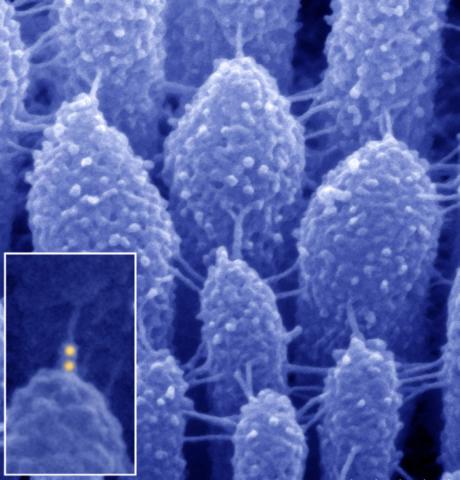NIDCD Lab Applies Gene Therapy to Hearing Loss

“When I first started to work on inner ear gene therapy, there wasn’t a lot of activity in the field,” said Chien, otolaryngology surgeon-scientist in NIDCD’s Inner Ear Gene Therapy Program. “Over the last few years, the field has flourished.”
Hearing loss is one of the most common communication disorders in the world. Aging, exposure to loud noise, head trauma, genetic mutations, some medications and bacterial infections can all lead to hearing loss.
“As patients lose their hearing, they become more socially withdrawn because they don’t want to embarrass themselves in front of their family members and friends. There’s a significant impact on the patient’s health as well as overall quality of life,” Chien said.
When a sound wave enters the ear, it travels through a narrow passage called the ear canal. There, it meets the eardrum. The sound waves strike the eardrum, which causes three tiny bones in the middle ear to vibrate. The vibrations travel to the cochlea, a fluid-filled structure shaped like a snail’s spiral shell, which activates the sensory cells in the inner ear called hair cells.
The hair cells translate the vibrations into electrical signals and auditory nerve fibers send the signals to the brain. The hair cells can detect a wide range of frequencies. Additionally, the vestibular organs in the inner ear help maintain a person’s balance.
For patients with mild to moderate hearing loss, hearing aids are one treatment option. However, only 14 percent of the U.S. population with hearing loss wears hearing aids. Chien thinks people are not aware of the problems that hearing loss causes, so they don’t appreciate the health benefits of hearing.
“Fortunately, this is rapidly changing” due to research, he said. “It’s my hope more and more people will realize the importance of treatment for hearing loss.”
Some people, particularly those with severe hearing loss, don’t find hearing aids effective. Many of Chien’s patients with severe hearing loss say hearing aids make sounds louder, not clearer.

Photo: NIDCD
For these patients, he said, cochlear implants are another treatment option. A cochlear implant is a device that stimulates the auditory nerve. The implant has external and internal parts. The external part includes a microphone, which relays information to the internal part, which transmits it to the cochlea.
“While hearing aids and cochlear implants are useful therapeutic options for patients with hearing loss, they are not perfect,” Chien said.
The lack of effective treatments inspired him to find new ones. His lab has focused on gene therapy as a potential treatment for both hearing loss and dizziness. Gene therapy is an experimental technique that modifies a person’s genes to treat a disease process.
Chien’s colleagues at NIDCD have helped to characterize a mutation found in the whirlin gene. Mutations in this gene are associated with Usher syndrome, a condition that affects hearing and vision. Deafness resulting from the syndrome is caused by the abnormal development of hair cells in the inner ear. The syndrome also causes balance problems.
To test the effectiveness of gene therapy at treating balance problems and hearing loss, Chien delivered normal copies of whirlin cDNA to the inner ear of mice with a mutation affecting the whirlin gene, which causes these mutant mice to be deaf and to spin around. The hope is to replace the mutated gene with a healthy copy of the gene. He found that gene therapy treatment caused these mutant mice to have longer stereocilia—the hair-like projections on the hair cells—than mice that didn’t get the gene therapy treatment. He found that the mutant mice that received gene therapy stopped spinning and started to walk in a straight line. In addition, he also found that these mutant mice could start to hear after gene therapy.

Chien said other researchers are also using gene-editing technologies, such as CRISPR-Cas9, to make changes in specific regions in the genome. In one study, Harvard University scientists prevented hearing loss in mice with hereditary deafness by using a gene-editing approach to disable a mutation that causes hearing loss. Research is ongoing.
“It’s a very exciting time to be working on inner ear gene therapy,” Chien concluded. “Through the collective effort of many investigators throughout the world, we hope to bring inner ear gene therapy from the bench to the bedside in the foreseeable future.”
